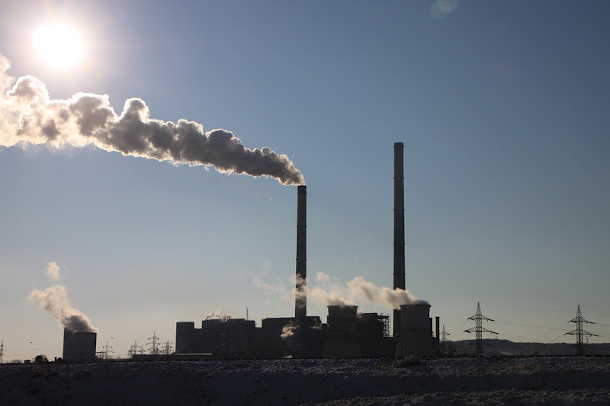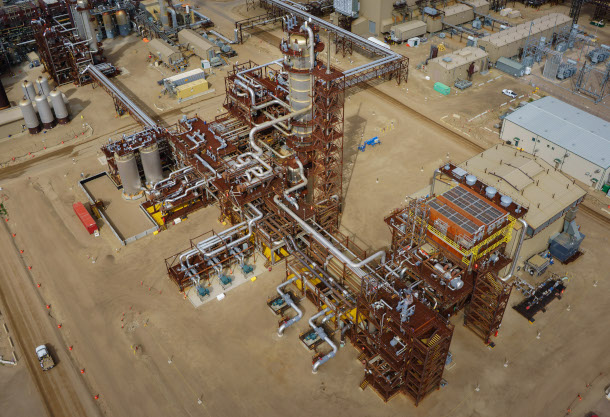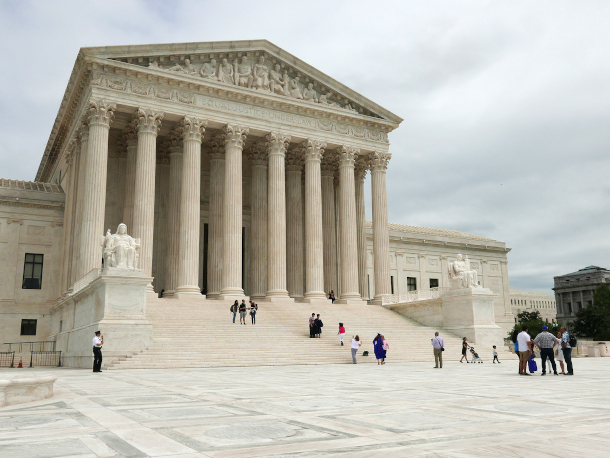A New Clean Power Plan
Air Date: Week of April 28, 2023

The Biden administration is putting forth new rules to curb greenhouse gas emissions from fossil fuel-fired power plants that will require carbon capture and sequestration in many instances. (Photo: Emilian Robert Vicol, Flickr, CC BY 2.0)
Under President Obama the Environmental Protection Agency tried to fight climate change by curbing overall emissions from the electric power sector, but those rules were blocked in court and then repealed by President Trump. Now the agency is trying again and it’s now backed up by provisions in the Inflation Reduction Act. Its new power plant emissions rules are crafted on a plant-by-plant basis designed to survive legal challenges, according to environmental law expert Pat Parenteau, who joins Host Steve Curwood to explain.
Transcript
BELTRAN: From PRX and the Jennifer and Ted Stanley Studios at the University of Massachusetts Boston, this is Living on Earth. I’m Paloma Beltran.
CURWOOD: And I’m Steve Curwood.
You may remember President Obama tried to fight climate change with Clean Power Plan rules to impose limits on natural gas and coal fired power plants, only to get blocked in court and then repealed by President Trump. Now the Biden Administration wants to make natural gas and coal power plants more climate friendly with different rules that rely on carbon capture and storage, a technology that has yet to be proven as cost effective. Power plants emit around a quarter of total global warming gases in the US, and since there are only about a thousand of them, it’s simpler for them to pave the way to net zero emissions, compared to changing energy systems for millions of cars, homes, and businesses. But that doesn’t mean it’s going to be easy. The new clean power plan rules will likely face challenges in court. For more, let’s welcome back Pat Parenteau, former EPA regional counsel and emeritus professor at Vermont Law School. Hi there Pat!
PARENTEAU: Hi, Steve, good to be with you.
CURWOOD: Great to have you back. Now, we are still working on a lot of speculation as we record this segment. But more and more is emerging about these proposed new standards every day. And from what you're seeing, Pat, what are these rules going to shake out to, do you think?
PARENTEAU: Well, EPA is taking its cue from the Supreme Court's decision in West Virginia v. EPA last year, just about a year ago. So this is going to be a technology-based rule that will rely on carbon capture and sequestration, which will enable individual plants to meet an emission reduction standard, which is what the Supreme Court and Chief Justice Roberts' majority opinion said EPA should do in addressing greenhouse gas emissions from the power plant sector. So from my standpoint, EPA is doing exactly what it's been told to do by the Supreme Court.
CURWOOD: Pat, in what ways is this a successor to the 2015 Clean Power Plan that President Obama and his folks tried to implement?

These upcoming standards focus on carbon capture and storage projects for new and existing power plants. (Photo: Alberta Newsroom, Flickr, CC BY-NC-ND 2.0)
PARENTEAU: Yes, the Obama plan relied heavily on what's called 'generation shifting'. In other words, that law requires EPA to establish the best system of emission reduction. And the Obama plan said, the best system is one that doesn't rely on fossil fuels, both coal and gas, the best system is one that relies on renewable energy, solar and wind. So that was the strategy that the Obama administration pursued. It's rational. It's cost effective. It's reliable. But the Supreme Court said, it's not lawful, because Congress didn't give EPA explicit enough authority to make that kind of major change to the nation's energy mix. So EPA has gone back to what I call its wheelhouse authority, under the Clean Air Act, and that's going to require technology very similar, by the way, to the scrubbers that EPA has used to reduce other pollutants. Sulfur dioxide, nitrogen oxide, the things that cause acid rain, etc. That's what EPA has said. Alright, if you want us to rely on technology, it's going to be expensive, it's probably going to be more expensive than shifting to renewable sources of energy, which have become very cost competitive with fossil fuel energy sources. But if that's what the Supreme Court says, is the limit of our authority, that's what we'll do.
CURWOOD: So Pat, let me just be clear, what do you think are the chances of the Supreme Court of the United States killing this rule as well?

The Biden administration’s rules will be a response to the West Virginia v. EPA case, which was decided in 2022 and said that the agency effectively does not have the power to regulate the mix of generation sources to address carbon dioxide emissions from power plants. (Photo: Susan Melkisethian, Flickr, CC BY-NC-ND 2.0)
PARENTEAU: Well, the big question is going to be cost and whether or not in the language of the law, carbon capture and sequestration has been, quote, adequately demonstrated. Now, we know it's been demonstrated. In fact, the fossil fuel industry is touting carbon capture as the way to allow it to continue to generate electricity from using gas and coal. But the question is, is it commercially available? Is it affordable? Or is it going to cause individual plants, particularly older plants, to simply go out of business, because the cost of retrofitting these old plants with new carbon capture technology is so expensive. And the thing that we want to watch in EPA's rule when it's finally issued is how is EPA dealing with the cost question? And the timing question of which plants will have to install this technology and by what date and so forth? So lots of detail yet to be revealed to figure out how is all this going to come together in a way that will pass muster with the Supreme Court? There's no question, you know, Attorney General Morrissey of West Virginia, the one who won the earlier case striking Obama's clean power plant has already drawn up the papers to challenge the rule the minute it's final. So we know there's going to be a legal challenge. And there's a very good chance the Supreme Court will take it up. Not a guarantee that the court will review it, but a pretty good chance that it will review it. So EPA is preparing this rule as if it has to win five votes on the Supreme Court.
CURWOOD: So carbon capture and storage is not cost effective these days, Pat. Just how expensive is it compared to how it would protect the climate?
President Biden pledged that the power business will decarbonize by 2035. The EPA is preparing to unveil standards for new and existing power plants that will replace Trump's American Clean Energy rule and Obama's Clean Power Plan https://t.co/VztGKhvRNZ pic.twitter.com/2qZajQLPYm
— Reuters (@Reuters) April 24, 2023
PARENTEAU: Yeah, it's fiendishly expensive, it can increase the cost of plants by 40% or more. So the way that EPA is going to frame this rule, it's going to rely heavily on the Inflation Reduction Act, which created of course $370 billion worth of investment in clean energy technology. By the way, that money that EPA and the federal government is putting up is going to be matched, according to the financial analysts, by an even greater amount of private capital. You know, when you spend federal money, public money, you leverage that against private capital. So the inflation Reduction Act actually might be tripled according to some analyses, in terms of investment. And the more of that investment that's going into an actually targeted to carbon capture gives EPA a very strong argument that Congress has expressly authorized EPA to both rely on carbon capture as a technology and put money into developing the systems so that the utilities can afford it. In addition to that, there is a tax credit already on the books, and it allows up to $85 per ton of CO2 emissions if it's done through carbon capture. So what I'm saying is there are a great number of financial incentives that Congress has created to underwrite carbon capture technology for electricity generation. EPA's rule is going to fold that kind of incentive into the regulatory structure to get over the argument that it's not affordable.
CURWOOD: So let me see if I have the strategy correct now from the Biden administration. Respond to the Supreme Court and do it power plant by power plant, make the requirement that they capture the greenhouse gases that come from the power plant, and then facilitate the money for them to install the technology?
PARENTEAU: Yeah, it's exactly right. It's a carrot and stick approach. It's the most traditional approach to environmental policy that we've had since the early 1970s. You provide some economic incentives, through tax credits, through direct subsidies, and so forth. But then you also impose through regulation, performance standards that drive down the emissions causing climate change. And it's that combination, as I've said, that is EPA's traditional approach for now 50 years to dealing with these kinds of air pollution. And now, of course, global pollution problems. And to me, the Supreme Court ought to look at what EPA has done, and simply say, good job, you've followed our instruction. And you've done what we've told you could do, and bless it. But we'll have to wait and see if they will actually follow my advice on that.
CURWOOD: By the way, Pat, how does this fit into the political cycle? We're, what, on the scale of 20 months away from either a new term for President Biden or somebody else? To what extent can these rules get done in time to survive a change of administration? Or is it frankly, already too late?

Pat Parenteau is emeritus professor of law at Vermont Law School and formerly served as EPA Regional Counsel. (Photo: Courtesy of Vermont Law School)
PARENTEAU: Now, that's a race, for sure. For new gas plants, the requirements apply automatically. Now, for coal fired power plants, and existing power plants, it's a different story. A lot of these coal plants are very old. In fact, you know, they're beyond in some respects, their normal, useful life. So one thing I will be looking for is how is EPA going to treat these dirty old coal plants. This is going to be a long, detailed rule and it will take a while I think, to figure out which plant has to actually install this carbon capture technology. And by what date. All of this is yet to be worked out. We were promised this rule, I mean, EPA announced that it would be out by the end of April. And now we're sort of reading that maybe it'll be May. So it'll come out as a proposed rule, there will have to be at least 60 days comment, and maybe more, and then it has to be finalized. And so now you're talking about getting this rule over the finish line and published in the Federal Register, you know, as fast as possible, because the Congressional Review Act is also going to be looming over this rule as that has over other rules so that if this rule isn't finalized, until next year, it's going to get caught in the Congressional Review Act, which means it's going to get caught in the election cycle that's coming up. So the faster that EPA can get this thing done, the better the chance that it might survive whatever is going to happen in the 2024 elections. And that's going to be a wildcard, obviously. A future administration, a future Congress could upset this once again, but you know, EPA can only do what it can control. So the sooner it can get this thing done, the better.
CURWOOD: Pat Parenteau is a former EPA regional counsel and emeritus professor at Vermont Law School. Pat, thanks so much for taking the time with us today.
PARENTEAU: My pleasure, Steve, thank you.
Links
Reuters | “Biden EPA to Issue Power Plant Rules That Lean on Carbon Capture”
Listen to our previous interview for a refresher on the case West Virginia v. EPA
Living on Earth wants to hear from you!
Living on Earth
62 Calef Highway, Suite 212
Lee, NH 03861
Telephone: 617-287-4121
E-mail: comments@loe.org
Newsletter [Click here]
Donate to Living on Earth!
Living on Earth is an independent media program and relies entirely on contributions from listeners and institutions supporting public service. Please donate now to preserve an independent environmental voice.
NewsletterLiving on Earth offers a weekly delivery of the show's rundown to your mailbox. Sign up for our newsletter today!
 Sailors For The Sea: Be the change you want to sea.
Sailors For The Sea: Be the change you want to sea.
 The Grantham Foundation for the Protection of the Environment: Committed to protecting and improving the health of the global environment.
The Grantham Foundation for the Protection of the Environment: Committed to protecting and improving the health of the global environment.
 Contribute to Living on Earth and receive, as our gift to you, an archival print of one of Mark Seth Lender's extraordinary wildlife photographs. Follow the link to see Mark's current collection of photographs.
Contribute to Living on Earth and receive, as our gift to you, an archival print of one of Mark Seth Lender's extraordinary wildlife photographs. Follow the link to see Mark's current collection of photographs.
 Buy a signed copy of Mark Seth Lender's book Smeagull the Seagull & support Living on Earth
Buy a signed copy of Mark Seth Lender's book Smeagull the Seagull & support Living on Earth

